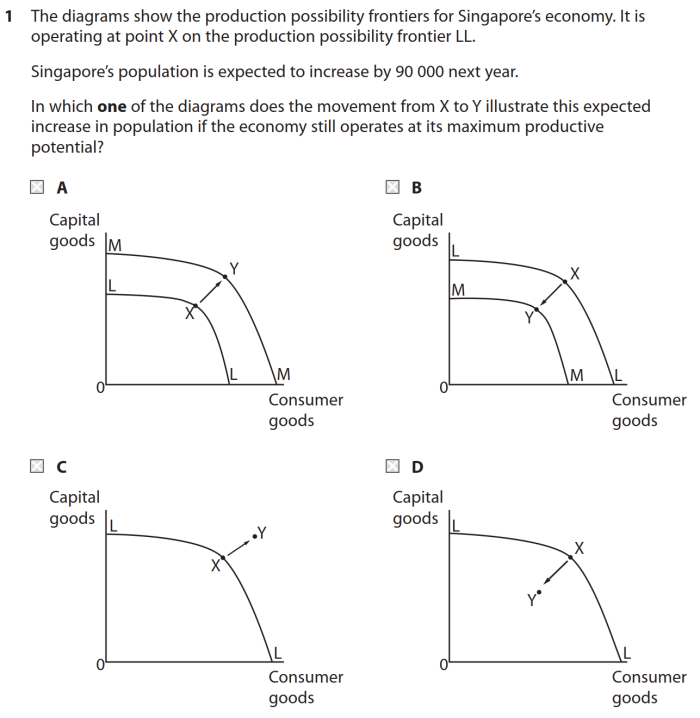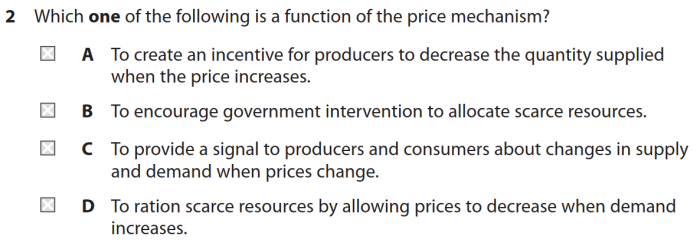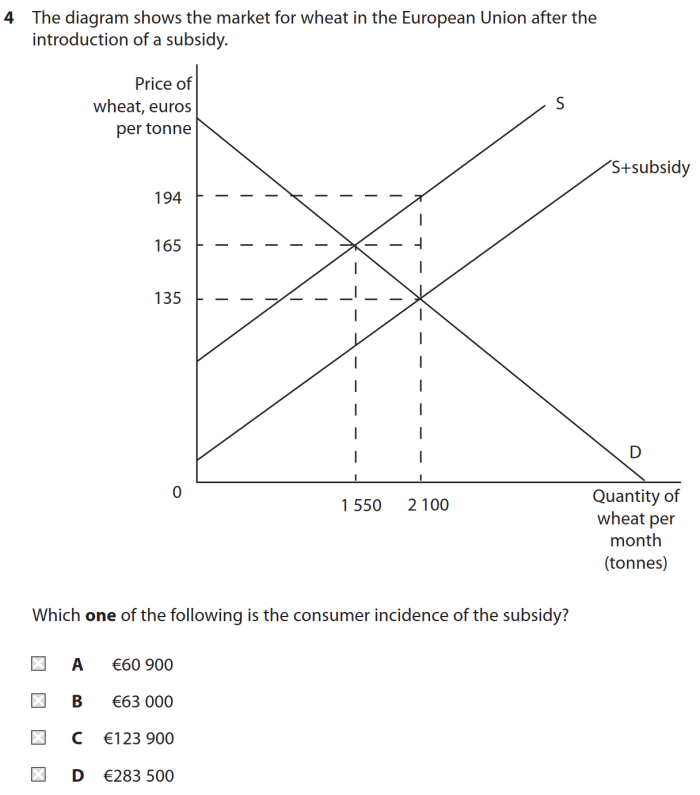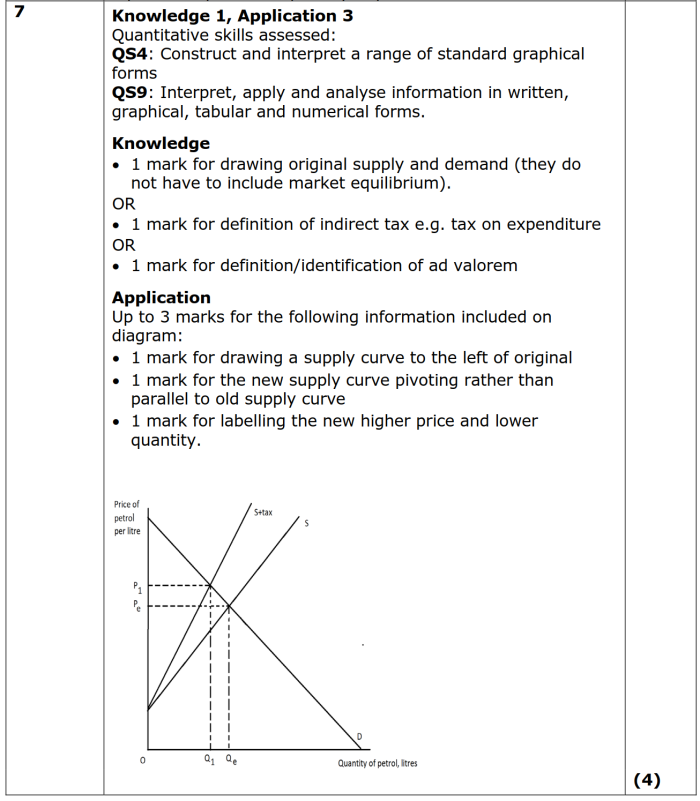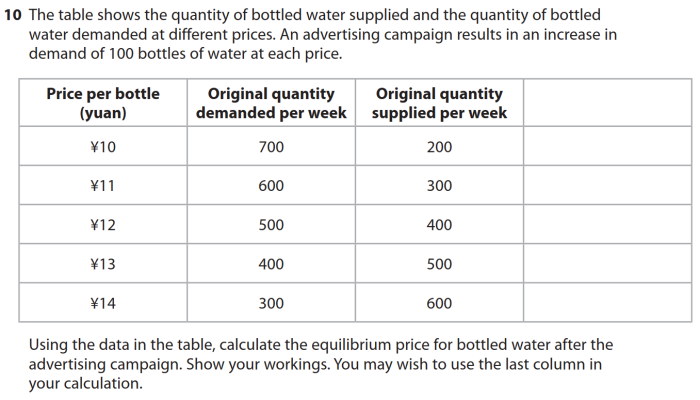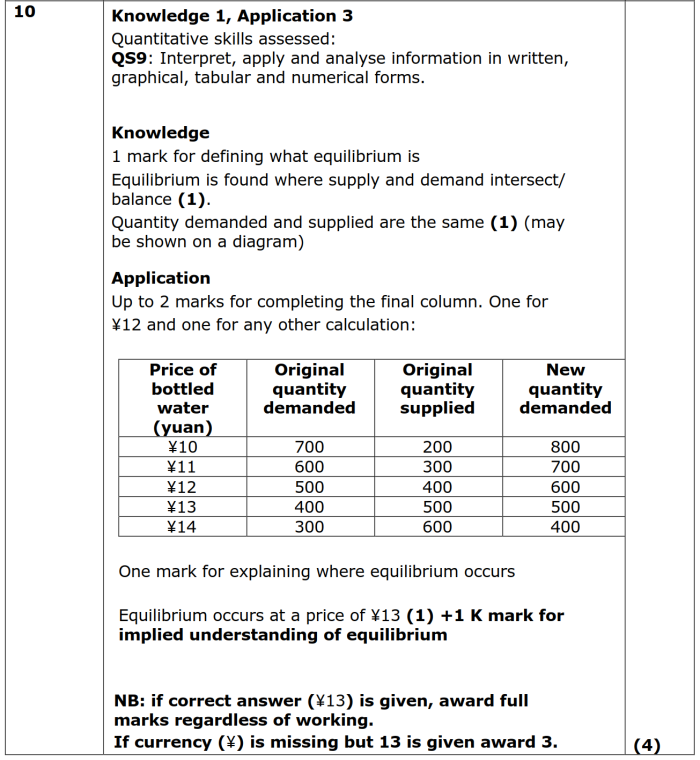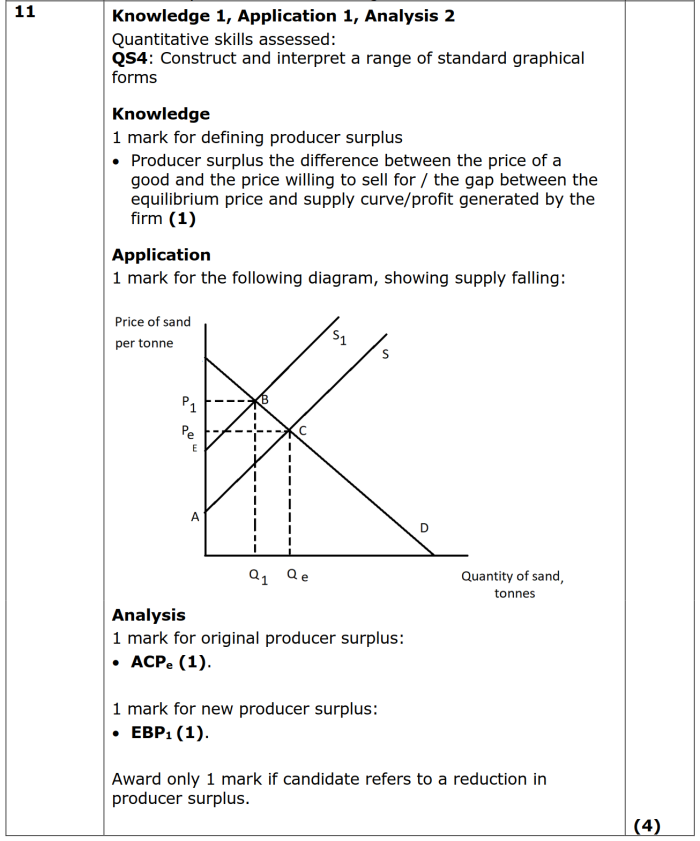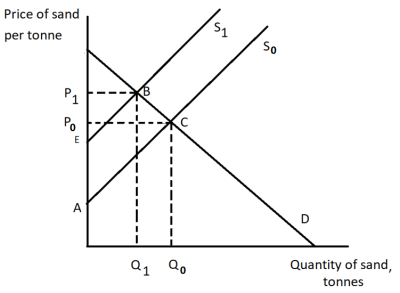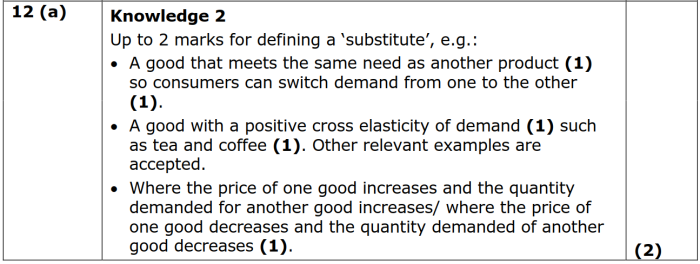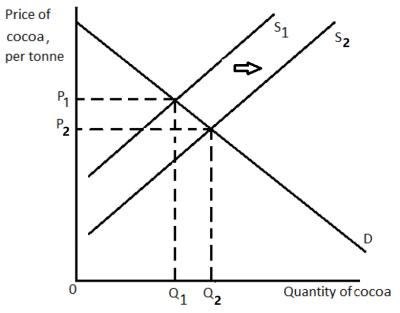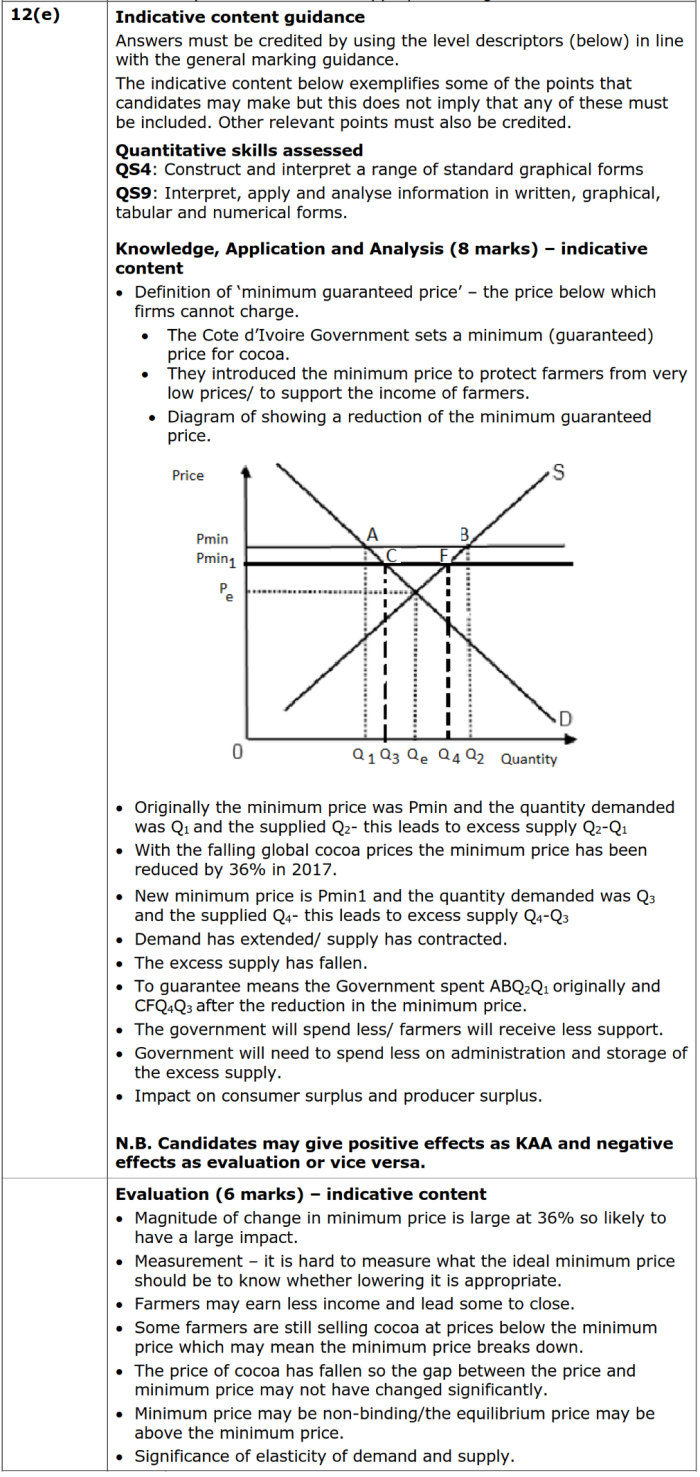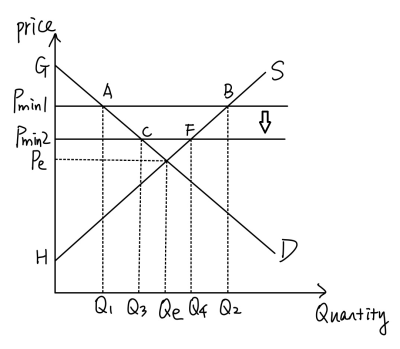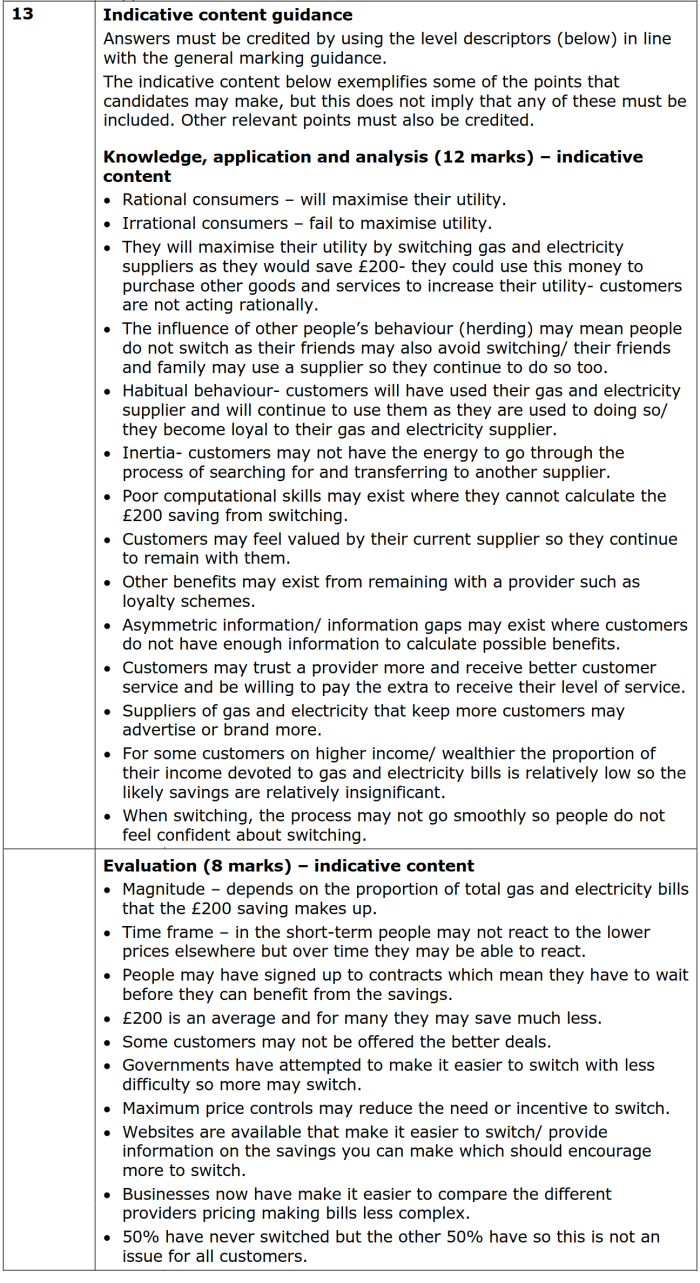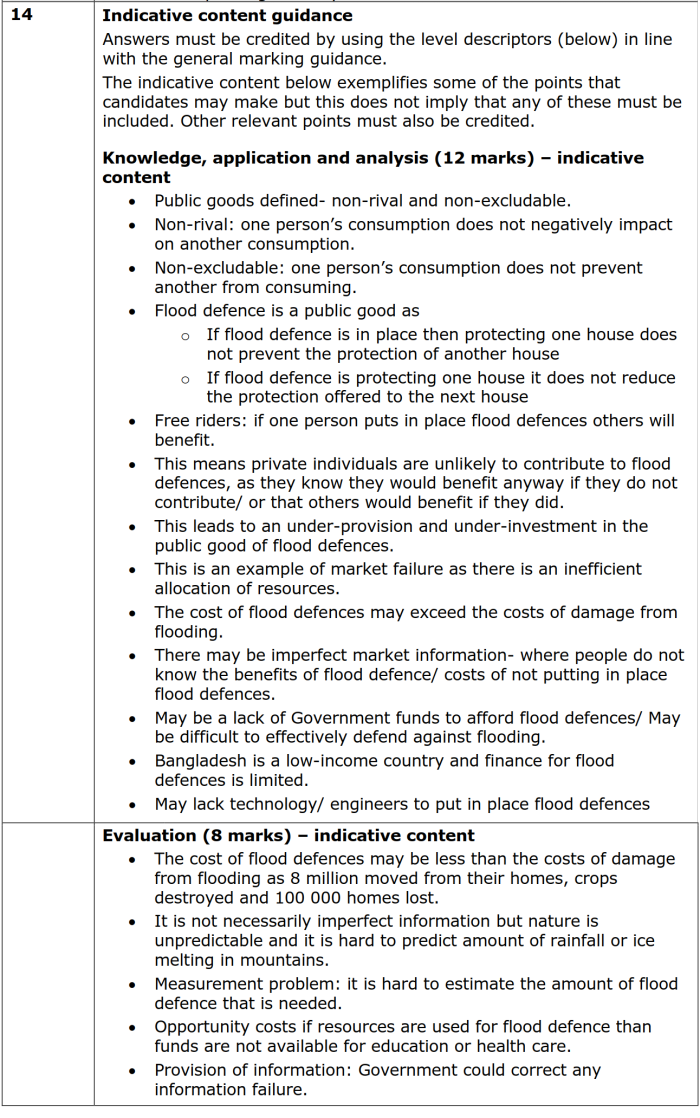“WEC11 01 que 20190109”的版本间的差异
(→8) |
(→12(b)) |
||
| (未显示同一用户的17个中间版本) | |||
| 第97行: | 第97行: | ||
| align="right"|'''答案''' || || <big><big>''' D'''</big></big> | | align="right"|'''答案''' || || <big><big>''' D'''</big></big> | ||
|- | |- | ||
| align="right"|'''难度''' || || {{Background color|# | | align="right"|'''难度''' || || {{Background color|#FFC20E|''' 中等 '''}} | ||
|- | |- | ||
| align="right" valign="top"|'''考察知识点''' || || YED在具体情境下的解读 | | align="right" valign="top"|'''考察知识点''' || || YED在具体情境下的解读 | ||
| 第196行: | 第196行: | ||
| align="right" valign="top" |'''参考例文'''|| || style="background: #F0FFF0"| <blockquote><span style="font-size:20px"><span style="font-family:Times New Roman,楷体"> | | align="right" valign="top" |'''参考例文'''|| || style="background: #F0FFF0"| <blockquote><span style="font-size:20px"><span style="font-family:Times New Roman,楷体"> | ||
{{color|red|'''(材料运用→)'''}}(填表格,每个价格处的new quantity demanded等于original quantity demanded加上100) | {{color|red|'''(材料运用→)'''}}(填表格,每个价格处的new quantity demanded等于original quantity demanded加上100) | ||
{{color|red|'''(概念→)'''}}Market equilibrium occurs where quantity demanded and supplied are the same. {{color|red|'''(分析与计算→)'''}}According to the table, when the price is | {{color|red|'''(概念→)'''}}Market equilibrium occurs where quantity demanded and quantity supplied are the same. {{color|red|'''(分析与计算→)'''}}According to the table, when the price is ¥13, new quantity demanded and quantity supplied are both 500. Therefore, the equilibrium price is ¥13. | ||
</span></span></blockquote> | </span></span></blockquote> | ||
|- | |- | ||
| 第202行: | 第202行: | ||
|} | |} | ||
<br/> | <br/> | ||
===11=== | ===11=== | ||
{| | {| | ||
| 第223行: | 第224行: | ||
</span></span></blockquote> | </span></span></blockquote> | ||
|- | |- | ||
| align="right" valign="top" |'''文字版备查'''|| ||<small>In Ho Chi Minh City, Vietnam, the price of sand increased from VND510 000 to VND695 000 per cubic metre between April and May 2017. This was caused by reduced supply from Vietnamese mining companies. Explain the likely impact of this change on producer surplus in the market for sand. Illustrate your answer with a diagram. | | align="right" valign="top" |'''文字版备查'''|| ||<small>In Ho Chi Minh City, Vietnam, the price of sand increased from VND510 000 to VND695 000 per cubic metre between April and May 2017. This was caused by reduced supply from Vietnamese mining companies. Explain the likely impact of this change on producer surplus in the market for sand. Illustrate your answer with a diagram.</small> | ||
</small> | |} | ||
<br/> | |||
===12=== | |||
<center> | |||
<big>{{Background color|#ffff00|''' 文章材料-中英对照 '''}}</big> | |||
{| class="wikitable" | |||
|- | |||
!原文!!参考译文(谷歌机翻) | |||
|-valign="top" <span style="font-size:30px"><span style="font-family:Arial,黑体"> | |||
|'''The market for cocoa'''<br/><br/> | |||
'''Extract A - The price of cocoa falls'''<br/><br/> | |||
Cocoa bean prices were high during 2015 and much of 2016 reflecting increased demand and decreased supply. For example, in 2016, consumption of cocoa exceeded production by 197 000 tonnes.<br/><br/> | |||
However, in 2017, production in the Côte d’Ivoire rose from 1.45 million tonnes to 1.93 million tonnes. The Côte d’Ivoire’s output increased after many new cocoa trees matured. Good cocoa harvests during 2017 led to stocks being 27.3% higher than in 2016. In April 2017, cocoa bean prices fell below $2 000 per tonne.<br/><br/> | |||
Cocoa trees take four to five years to mature and produce cocoa pods. Cocoa trees grow best in regions near the equator. This means very few countries can successfully grow the crop.<br/><br/> | |||
In contrast, the prices of substitutes for cocoa such as tea and coffee increased during 2017.<br/><br/> | |||
<br/> | |||
'''Extract B – Cocoa production can damage the environment'''<br/><br/> | |||
Poor management of land used to produce cocoa means rainforest has to be destroyed so new plantations can be started. Soil erosion, caused by growing too much cocoa, makes the land less fertile and reduces crop yield. To increase production, some farmers have started to use fertilisers which cause river pollution.<br/><br/> | |||
Farmers should be removing old cocoa trees and allowing the land to recover. Many cannot afford to do this because they need to earn revenue until the replacement trees grow. The continued use of older trees results in lower yields. Consequently farmers seek new land by destroying rainforests. In Indonesia the amount of land that is rainforest has fallen from 30% to closer to 15%. This has a significant negative impact on biodiversity.<br/><br/> | |||
However, the Rainforest Alliance trains cocoa farmers on how to manage their trees to avoid environmental damage. Between 2009 to 2015 the amount of cocoa produced by Rainforest Alliance farms increased from 2% to 16%.<br/><br/> | |||
<br/> | |||
'''Extract C – Minimum price scheme in the Côte d’Ivoire'''<br/><br/> | |||
The Côte d’Ivoire Government sets a minimum (guaranteed) price for cocoa. In 2017, it reduced the minimum price by 36% to cut government spending and reduce cocoa stocks. However, some farmers still sell cocoa at prices below the minimum price because they can receive payments more quickly than from the Government. | |||
||'''可可市场'''<br/><br/> | |||
'''摘录A - 可可价格下跌'''<br/><br/> | |||
可可豆价格在 2015 年和 2016 年大部分时间都处于高位,反映出需求增加和供应减少。例如,2016 年,可可消费量超过产量 19.7 万吨。<br/><br/> | |||
然而,2017 年,科特迪瓦的产量从 145 万吨增加到 193 万吨。 许多新的可可树成熟后,科特迪瓦的产量有所增加。 2017 年可可丰收导致库存比 2016 年高出 27.3%。2017 年 4 月,可可豆价格跌破每吨 2000 美元。<br/><br/> | |||
可可树需要四到五年才能成熟并结出可可豆荚。可可树在赤道附近地区生长最好。 这意味着很少有国家能够成功种植这种作物。<br/><br/> | |||
相比之下,茶和咖啡等可可替代品的价格在 2017 年上涨。<br/><br/> | |||
<br/> | |||
'''摘录 B – 可可生产会破坏环境'''<br/><br/> | |||
用于生产可可的土地管理不善意味着必须摧毁雨林才能开始新的种植园。可可种植过多引起的水土流失使土地变得不肥沃,并降低了作物产量。为了增加产量,一些农民开始使用造成河流污染的化肥。<br/><br/> | |||
农民应该移除老可可树,让土地恢复原状。许多人负担不起这样做,因为他们需要在替代树木长出之前赚取收入。继续使用老树会导致产量降低。因此,农民通过破坏热带雨林来寻找新的土地。在印度尼西亚,热带雨林的面积已从 30% 下降到接近 15%。 这对生物多样性产生了重大的负面影响。<br/><br/> | |||
然而,雨林联盟培训可可种植者如何管理他们的树木以避免环境破坏。 2009 年至 2015 年间,雨林联盟农场的可可产量从 2% 增加到 16%。<br/><br/> | |||
<br/> | |||
'''摘录 C——科特迪瓦的最低价格方案'''<br/><br/> | |||
科特迪瓦政府为可可设定了最低(保证)价格。2017 年,它将最低价格降低了 36%,以削减政府开支并减少可可库存。 然而,一些农民仍然以低于最低价格的价格出售可可,因为他们可以比政府更快地收到付款。 | |||
|} | |||
</center> | |||
<center>[[File:EdxAL_2019_01_P1_12_z1.png|700px]]</center> | |||
<br/> | |||
====12(a)==== | |||
{| | |||
|- | |||
| align="right" valign="top" |'''题目'''|| || style="background: #FAF0E6"| [[File:EdxAL_2019_01_P1_12_a1.png|700px]] | |||
|- | |||
| align="right" |'''题目类型'''|| || '''定义题''' | |||
|- | |||
| align="right" valign="top" |'''难度''' || || {{Background color|#00FF00|''' 容易 '''}} | |||
|- | |||
| align="right" valign="top" |'''考察知识点'''|| || substitute的定义 | |||
|- | |||
| align="right" valign="top" width="100px" |'''解答要点'''|| || ● 默写substitute的定义,并使用括号中指明的文段位置来说明该定义。 | |||
|- | |||
| align="right" valign="top" |'''官方答案'''|| || style="background: #d3d3d3"| [[File:EdxAL_2019_01_P1_12_a2.png|700px]] | |||
|- | |||
| align="right" valign="top" |'''参考例文'''|| || style="background: #F0FFF0"| <blockquote><span style="font-size:20px"><span style="font-family:Times New Roman,楷体"> | |||
{{color|red|'''(概念→)'''}}A substitute is a good that meets the same need as another product so consumers can switch demand from one to the other. {{color|red|'''(引用指定文段内容→)'''}}According to Extract A, tea and coffee are substitutes of cocoa. | |||
</span></span></blockquote> | |||
|- | |||
| align="right" valign="top" |'''文字版备查'''|| ||<small>Define the term ‘substitutes’ (Extract A, line 12).</small> | |||
|} | |||
<br/> | |||
====12(b)==== | |||
{| | |||
|- | |||
| align="right" valign="top" |'''题目'''|| || style="background: #FAF0E6"| [[File:EdxAL_2019_01_P1_12_b1.png|700px]] | |||
|- | |||
| align="right" |'''题目类型'''|| || '''解释原因题''' | |||
|- | |||
| align="right" valign="top" |'''难度''' || || {{Background color|#FFC20E|''' 中等 '''}} | |||
|- | |||
| align="right" valign="top" |'''考察知识点'''|| || PES的影响因素 | |||
|- | |||
| align="right" valign="top" width="100px" |'''解答要点'''|| || ● 给出PES定义,根据文段内容指出一个PES的影响因素,并结合文段分析cocoa beans的PES是elastic还是inelastic。 | |||
|- | |||
| align="right" valign="top" |'''官方答案'''|| || style="background: #d3d3d3"| [[File:EdxAL_2019_01_P1_12_b2.png|700px]] | |||
|- | |||
| align="right" valign="top" |'''参考例文'''|| || style="background: #F0FFF0"| <blockquote><span style="font-size:20px"><span style="font-family:Times New Roman,楷体"> | |||
{{color|red|'''(概念→)'''}}Price elasticity of supply means the responsiveness of quantity supplied to a change in the price. Inelastic supply is where a change in price will see a smaller percentage change in quantity supplied.<br/> | |||
<br/> | |||
{{color|red|'''(指出影响因素→)'''}}Time is one factor to influence PES. {{color|red|'''(引用指定文段内容→)'''}}According to Extract A, cocoa trees take four to five years to mature and produce cocoa pods. {{color|red|'''(紧扣概念进行说明分析→)'''}}When price of cocoa increases, the quantity supplied of cocoa is difficult to increase as quickly as the price because cocoa needs time to mature. Therefore, PES of cocoa would be inelastic. | |||
</span></span></blockquote> | |||
|- | |||
| align="right" valign="top" |'''文字版备查'''|| ||<small>With reference to Extract A, explain one factor that is likely to influence the price elasticity of supply for cocoa beans.</small> | |||
|} | |||
<br/> | |||
====12(c)==== | |||
{| | |||
|- | |||
| align="right" valign="top" |'''题目'''|| || style="background: #FAF0E6"| [[File:EdxAL_2019_01_P1_12_c1.png|700px]] | |||
|- | |||
| align="right" |'''题目类型'''|| || '''解释原因题+画图''' | |||
|- | |||
| align="right" valign="top" |'''难度''' || || {{Background color|#FFC20E|''' 中等 '''}} | |||
|- | |||
| align="right" valign="top" |'''考察知识点'''|| || 影响Demand或Supply曲线的因素 | |||
|- | |||
| align="right" valign="top" width="100px" |'''解答要点'''|| || ● 从指定文段中找出影响因素,解释如何影响了D或S,并画出图像。对指定图像的引用需要描述其趋势、具体时间点以及具体数值。 | |||
|- | |||
| align="right" valign="top" |'''官方答案'''|| || style="background: #d3d3d3"| [[File:EdxAL_2019_01_P1_12_c2.png|700px]] | |||
|- | |||
| align="right" valign="top" |'''参考例文'''|| || style="background: #F0FFF0"| <blockquote><span style="font-size:20px"><span style="font-family:Times New Roman,楷体"> | |||
{{color|red|'''(指出影响因素→)'''}}One reason to decrease the price of cocoa is good harvest in Côte d’Ivoire. {{color|red|'''(引用指定文段内容→)'''}}According to Extract A, good cocoa harvests during 2017 led to production in the Côte d’Ivoire rising from 1.45 million tonnes to 1.93 million tonnes. {{color|red|'''(指出对D或S的影响→)'''}}It makes the supply curve shift rightwards from S<sub>1</sub> to S<sub>2</sub>, shown in the diagram.<br/> | |||
<center>[[File:EdxAL_2019_01_P1_12_c3.png|400px]]</center> | |||
{{color|red|'''(紧扣问题给出解答→)'''}}Therefore, the equilibrium price decreases from P<sub>1</sub> to P<sub>2</sub>. {{color|red|'''(引用指定文段内容→)'''}}According to Figure 1, the price of cocoa fell from 3100$ per tonne in June 2016 to 1950$ per tonne in April 2017. | |||
</span></span></blockquote> | |||
|- | |||
| align="right" valign="top" |'''文字版备查'''|| ||<small>With reference to Figure 1 and Extract A, analyse one reason why the price of cocoa beans ‘fell below $2 000 per tonne’ (Extract A, line 8) in April 2017. Illustrate your answer with a supply and demand diagram.</small> | |||
|} | |||
<br/> | |||
====12(d)==== | |||
{| | |||
|- | |||
| align="right" valign="top" |'''题目'''|| || style="background: #FAF0E6"| [[File:EdxAL_2019_01_P1_12_d1.png|700px]] | |||
|- | |||
| align="right" |'''题目类型'''|| || '''解释影响题''' | |||
|- | |||
| align="right" valign="top" |'''难度''' || || {{Background color|#FFC20E|''' 中等 '''}} | |||
|- | |||
| align="right" valign="top" |'''考察知识点'''|| || external cost的定义及影响 | |||
|- | |||
| align="right" valign="top" width="100px" |'''解答要点'''|| || ● 给出external cost的定义,从指定文段中总结归纳出2种external cost的实例及具体影响,并给出评价。 | |||
|- | |||
| align="right" valign="top" |'''官方答案'''|| || style="background: #d3d3d3"| [[File:EdxAL_2019_01_P1_12_d2.png|700px]] | |||
|- | |||
| align="right" valign="top" |'''参考例文'''|| || style="background: #F0FFF0"| <blockquote><span style="font-size:20px"><span style="font-family:Times New Roman,楷体"> | |||
{{color|red|'''(概念→)'''}}External costs are negative impacts on third parties, where MSC are above MPC. They are examples of market failure.<br/> | |||
<br/> | |||
{{color|red|'''(指出影响1→)'''}}One external cost is deforestation. {{color|red|'''(引用指定文段内容→)'''}}According to Extract B, rainforest has to be destroyed to start new plantations of cocoa. {{color|red|'''(结合自己了解的知识分析具体影响→)'''}}Less trees are available to turn carbon dioxide into oxygen, causing global warming and extreme weather conditions around the world. {{color|red|'''(评价→)'''}}However, external cost may be balanced with external benefits. New plantations of cocoa will increase income of local farmers and raise their living standards.<br/> | |||
<br/> | |||
{{color|red|'''(指出影响2→)'''}}Another external cost is water pollution. {{color|red|'''(引用指定文段内容→)'''}}According to Extract B, some farmers have started to use fertilisers to increase production of cocoa. {{color|red|'''(结合自己了解的知识分析具体影响→)'''}}As fertilisers may include some toxic chemicals, they could bring water pollution, causing large loss on fishing industry and negative impacts on people' health issues. Fish would die because of polluted water, and people who eat these fish could have stomachache, vomiting or even cancers. {{color|red|'''(评价→)'''}}However, the extent of external costs depends on the quantity of fertilisers. If farmers only use a few level of fertilisers, the external costs mentioned above could be very little. | |||
</span></span></blockquote> | |||
|- | |||
| align="right" valign="top" |'''文字版备查'''|| ||<small>With reference to Extract B, examine the external costs associated with the production of cocoa beans.</small> | |||
|} | |||
<br/> | |||
====12(e)==== | |||
{| | |||
|- | |||
| align="right" valign="top" |'''题目'''|| || style="background: #FAF0E6"| [[File:EdxAL_2019_01_P1_12_e1.png|700px]] | |||
|- | |||
| align="right" |'''题目类型'''|| || '''解释影响题''' | |||
|- | |||
| align="right" valign="top" |'''难度''' || || {{Background color|red|{{color|white|''' 困难 '''}}}} | |||
|- | |||
| align="right" valign="top" |'''考察知识点'''|| || minimum price的影响 | |||
|- | |||
| align="right" valign="top" width="100px" |'''解答要点'''|| || ● 给出minimum price的定义,指出至少3个方面的影响,比如surplus的变化、consumer surplus或producer surplus的变化、政府行为的变化等。 | |||
|- | |||
| align="right" valign="top" |'''官方答案'''|| || style="background: #d3d3d3"| [[File:EdxAL_2019_01_P1_12_e2.png|700px]] | |||
|- | |||
| align="right" valign="top" |'''参考例文'''|| || style="background: #F0FFF0"| <blockquote><span style="font-size:20px"><span style="font-family:Times New Roman,楷体"> | |||
{{color|red|'''(概念→)'''}}Minimum guaranteed price is the price below which firms cannot charge. {{color|red|'''(背景材料引用→)'''}}According to Extract C, the Côte d’Ivoire Government sets a minimum guaranteed price for cocoa, and in 2017 it reduced the minimum price by 36%.<br/> | |||
<br/> | |||
{{color|red|'''(指出影响1→)'''}}One effect is the decreasing surplus of cocoa. {{color|red|'''(解释分析→)'''}}When the government reduced the minimum price from P<sub>min1</sub> to P<sub>min2</sub> (shown in the diagram), the quantity demanded increased from Q<sub>1</sub> to Q<sub>3</sub>, and the quantity supplied decreased from Q<sub>2</sub> to Q<sub>4</sub>. Therefore, surplus fell from AB to CF. {{color|red|'''(评价→)'''}}However, the excess supply in the cocoa market still exists if new minimum price is above market equilibrium price. Resources are wasted and there would be extra costs for storing redundant cocoa.<br/> | |||
<center>[[File:EdxAL_2019_01_P1_12_e3.png|400px]]</center> | |||
{{color|red|'''(指出影响2→)'''}}Another effect is increasing consumer surplus and decreasing producer surplus. {{color|red|'''(解释分析→)'''}}When the government reduced the minimum price from Pmin1 to Pmin2 (shown in the diagram), consumer surplus rose from GAP<sub>min1</sub> to GCP<sub>min2</sub> and producer surplus fell from HBP<sub>min1</sub> to HFP<sub>min2</sub>. It means consumers gain more welfare from decreasing minimum price while producers have some welfare loss. {{color|red|'''(评价→)'''}}It has to be noted that the extent of effect depends on the level of change in minimum price. According to Extract C, change in minimum price is large at 36%, so the impact could be large as well.<br/> | |||
<br/> | |||
{{color|red|'''(指出影响3→)'''}}What's more, the government will spend less money for excess supply. {{color|red|'''(解释分析→)'''}}When there are surpluses in the market, the government has to spend money to buy them in order to keep the minimum price. As mentioned above, the surplus would decrease as minimum price fell down. Therefore, the government could spend less money on it. Instead of that, the government can use these money to build more roads, hospitals and schools, and increase people's living standards. {{color|red|'''(评价→)'''}}However, some farmers will have losses after a lack of government spending on cocoa. Their income will decrease because of falling minimum price and their living standards could deteriorate.<br/> | |||
<br/> | |||
{{color|red|'''(结合问题总结上文观点→)'''}}In summary, impacts of decreasing minimum price include decreasing surplus of cocoa, increasing consumer surplus and decreasing producer surplus and less money spent by the government. | |||
</span></span></blockquote> | |||
|- | |||
| align="right" valign="top" |'''文字版备查'''|| ||<small>With reference to Extract C, discuss the likely effects of the reduction in the minimum (guaranteed) price for cocoa. Illustrate your answer with an appropriate diagram.</small> | |||
|} | |||
<br/> | |||
===13=== | |||
{| | |||
|- | |||
| align="right" valign="top" |'''题目'''|| || style="background: #FAF0E6"| [[File:EdxAL_2019_01_P1_13_1.png|700px]] | |||
|- | |||
| align="right" |'''题目类型'''|| || '''解释原因题''' | |||
|- | |||
| align="right" valign="top" |'''难度''' || || {{Background color|red|{{color|white|''' 困难 '''}}}} | |||
|- | |||
| align="right" valign="top" |'''考察知识点'''|| || 人们出现irrational behaviour的原因 | |||
|- | |||
| align="right" valign="top" width="100px" |'''解答要点'''|| || ● 写出irrational behaviour的定义,给出至少4个可能的原因并进行分析和评价。 | |||
|- | |||
| align="right" valign="top" |'''官方答案'''|| || style="background: #d3d3d3"| [[File:EdxAL_2019_01_P1_13_2.png|700px]] | |||
|- | |||
| align="right" valign="top" |'''参考例文'''|| || style="background: #F0FFF0"| <blockquote><span style="font-size:20px"><span style="font-family:Times New Roman,楷体"> | |||
{{color|red|'''(概念→)'''}}Irrational behaviours occur when consumers fail to maximise their utilities. {{color|red|'''(背景材料引用→)'''}}50% of gas and electricity consumers in the UK have never switched energy suppliers, although switching suppliers could save up to £200 each per year. {{color|red|'''(结合概念分析→)'''}}It is an example of irrational behaviours because people could use these money to buy more goods and increase their living standards if they changed their suppliers.<br/> | |||
<br/> | |||
{{color|red|'''(指出原因1→)'''}}One reason of irrational behaviours is the influence of other people's behaviour. {{color|red|'''(解释分析→)'''}}If their relatives and friends do not change energy suppliers, consumers may not change their energy suppliers as well. They may just want to keep the same choices with people around and not be considered as strange people. {{color|red|'''(评价→)'''}}However, £200 is a large amount, which can attract many people to change their choices. There are also another 50% of consumers who have changed their mind in the extract.<br/> | |||
<br/> | |||
{{color|red|'''(指出原因2→)'''}}Another reason is the habitual behaviour. {{color|red|'''(解释分析→)'''}}Some consumers have been accustomed to their present energy suppliers and do not want to change a new one, because they may spend more time to know basic operations of new suppliers. {{color|red|'''(评价→)'''}}However, it depends on the time frame. After a long time, more consumers will accept new suppliers and are glad to use them.<br/> | |||
<br/> | |||
{{color|red|'''(指出原因3→)'''}}The third reason is information gaps. {{color|red|'''(解释分析→)'''}}Some consumers may not have enough information to calculate possible benefits of changing energy suppliers. They could underestimate money they could save, or they may even do not know they can save money if they change to new suppliers. {{color|red|'''(评价→)'''}}However, websites are available to make it easier for consumers to search information. The information gaps will become smaller, which may reduce irrational behaviours of consumers.<br/> | |||
<br/> | |||
{{color|red|'''(指出原因4→)'''}}In addition, inertia can also cause irration behaviours. {{color|red|'''(解释分析→)'''}}People may spend a lot of time to go through the process of searching for and transferring to another supplier. Therefore, they prefer to use present energy suppliers rather than transfer to a new one. {{color|red|'''(评价→)'''}}However, some people may have signed up to contracts which mean they have to wait before their contracts end up. So they cannot change their choices now.<br/> | |||
<br/> | |||
{{color|red|'''(结合问题总结上文观点→)'''}}In summary, reasons of irrational behaviours include herding behaviours, habitual behaviours, information gaps and inertia. | |||
</span></span></blockquote> | |||
|- | |||
| align="right" valign="top" |'''文字版备查'''|| ||<small>In 2016 it was reported that 50% of gas and electricity consumers in the UK have never switched energy suppliers. It is claimed that those consumers who did switch suppliers saved up to £200 each per year. Evaluate the reasons why many consumers do not switch energy suppliers.</small> | |||
|} | |||
<br/> | |||
===14=== | |||
{| | |||
|- | |||
| align="right" valign="top" |'''题目'''|| || style="background: #FAF0E6"| [[File:EdxAL_2019_01_P1_14_1.png|700px]] | |||
|- | |||
| align="right" |'''题目类型'''|| || '''解释原因题''' | |||
|- | |||
| align="right" valign="top" |'''难度''' || || {{Background color|red|{{color|white|''' 困难 '''}}}} | |||
|- | |||
| align="right" valign="top" |'''考察知识点'''|| || public goods相关知识 | |||
|- | |||
| align="right" valign="top" width="100px" |'''解答要点'''|| || ● 主要针对public good导致私企投资不足的观点进行分析,此外再结合生活知识指出3个其他导致投资不足的原因。 | |||
|- | |||
| align="right" valign="top" |'''官方答案'''|| || style="background: #d3d3d3"| [[File:EdxAL_2019_01_P1_14_2.png|700px]] | |||
|- | |||
| align="right" valign="top" |'''参考例文'''|| || style="background: #F0FFF0"| <blockquote><span style="font-size:20px"><span style="font-family:Times New Roman,楷体"> | |||
{{color|red|'''(指出观点1→)'''}}One reason of under-investment is the existance of public good. {{color|red|'''(概念与解释分析→)'''}}A public good is the good which is non-excludable and non-rival. Non-excludability means one person's consumption does not prevent another from consuming. If flood defence is in place then protecting one house does not prevent the protection of another house, so flood defences meet the characteristic of non-excludability. Non-rival means one person's consumption does not negatively impact on another consumption. If flood defence is protecting one house it does not reduce the protection offered to the next house, so flood defences meet the characteristic of non-rivalry. Therefore, flood defence is an example of public good.<br/> | |||
<br/> | |||
{{color|red|'''(概念→)'''}}Free rider problem occurs normally for public goods. {{color|red|'''(解释分析→)'''}}If one person puts in place flood defences, others will benefit without paying any costs. It means private individuals are unlikely to contribute to flood defences, as they know they cannot make profits from building flood defences. Hence, it leads to an under-provision and under-investment in the public good of flood defences.<br/> | |||
<br/> | |||
{{color|red|'''(评价→)'''}}However, the government can build flood defences directly using its government revenue. It will correct the under-investment by private firms and reduce the negative impact by this market failure.<br/> | |||
<br/> | |||
{{color|red|'''(指出观点2→)'''}}Another reason is information gaps. {{color|red|'''(解释分析→)'''}}People may not have enough information to estimate benefits of building flood defences. Benefits are under-estimated, so firms do not want to invest much money for flood defences. {{color|red|'''(评价→)'''}}However, websites are available for people to search information about flood defences. The information gaps will become smaller and the negative impact can decrease as well.<br/> | |||
<br/> | |||
{{color|red|'''(指出观点3→)'''}}The third reason is a lack of funds. {{color|red|'''(解释分析→)'''}}The government may not have enough money to build flood defences as there are budget deficits in recent years. The government may aim to develop healthcare and education at first, so there are not enough money for infrastructure. {{color|red|'''(评价→)'''}}However, it depends on the amount of money for flood defences. If the amount is not too much, the government may slove the fund problem by borrowing.<br/> | |||
<br/> | |||
{{color|red|'''(指出观点4→)'''}}In addition, a lack of technology can be another reason. {{color|red|'''(解释分析→)'''}}As Bangladesh is a developing country, it may not have enough technology, machines or skilled engineers to build flood defences. Therefore, the government may have under-investment for this project. {{color|red|'''(评价→)'''}}However, the government can invite engineers from abroad to help domestic citizens to build this project. The negative impact caused by lacking technology could reduce.<br/> | |||
<br/> | |||
{{color|red|'''(结合问题总结上文观点→)'''}}In summary, the reasons of under-investment include the existance of public goods, information gaps, a lack of funds and a lack of technology. | |||
</span></span></blockquote> | |||
|- | |||
| align="right" valign="top" |'''文字版备查'''|| ||<small>In 2017 floods in Bangladesh resulted in 8 million people having to move from their homes. 100 000 houses were destroyed and many crops were lost. The Institute of Water and Flood Management claim that there had been an under-investment in flood defences. Evaluate reasons for this under-investment in flood defences. Make reference to public goods in your answer.</small> | |||
|} | |} | ||
<br/> | <br/> | ||
2023年2月12日 (日) 12:02的最新版本
单题搜索方法:右上角搜索中输入该题中的部分文字,点击搜索后进入相关页面,然后使用ctrl+F5(或其他按键组合调出搜索框),再次搜索该题干文字,直接定位到题目。
整卷下载
- 试卷请点击此处 ⇒ 【2019 冬季 U1】
- 答案请点击此处 ⇒ 【2019 冬季 U1 mark scheme】
题目解答
1
2
3
4
5
| 题目 | 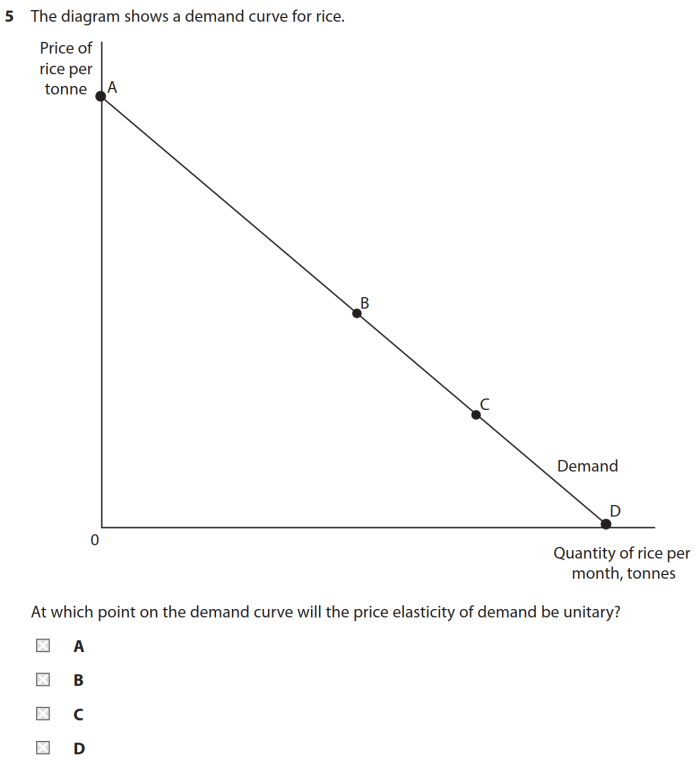
| |
| 答案 | B | |
| 难度 | 容易 | |
| 考察知识点 | Demand线上各点的PED值 | |
| 解答要点 | ● 单位弹性位于D线的中点位置,因此B选项正确。 | |
| 文字版备查 | The diagram shows a demand curve for rice. At which point on the demand curve will the price elasticity of demand be unitary? |
6
7
8
9
10
11
12
文章材料-中英对照
| 原文 | 参考译文(谷歌机翻) |
|---|---|
| The market for cocoa Extract A - The price of cocoa falls |
可可市场 摘录A - 可可价格下跌 |
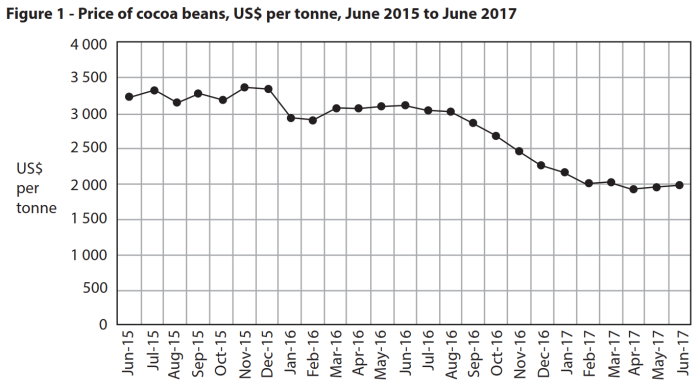
12(a)
12(b)
12(c)
12(d)
12(e)
13
14
